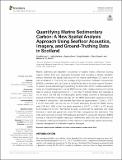Files in this item
Quantifying marine sedimentary carbon : a new spatial analysis approach using seafloor acoustics, imagery, and ground-truthing data in Scotland
Item metadata
| dc.contributor.author | Hunt, Corallie Anne | |
| dc.contributor.author | Demsar, Urska | |
| dc.contributor.author | Dove, Dayton | |
| dc.contributor.author | Smeaton, Craig | |
| dc.contributor.author | Cooper, Rhys | |
| dc.contributor.author | Austin, William | |
| dc.date.accessioned | 2020-07-28T09:30:06Z | |
| dc.date.available | 2020-07-28T09:30:06Z | |
| dc.date.issued | 2020-07-28 | |
| dc.identifier | 268707369 | |
| dc.identifier | de7c6d0e-aadf-45fe-9254-055cf2abf79c | |
| dc.identifier | 000553446800001 | |
| dc.identifier | 85089345687 | |
| dc.identifier.citation | Hunt , C A , Demsar , U , Dove , D , Smeaton , C , Cooper , R & Austin , W 2020 , ' Quantifying marine sedimentary carbon : a new spatial analysis approach using seafloor acoustics, imagery, and ground-truthing data in Scotland ' , Frontiers in Marine Science , vol. 7 , 588 . https://doi.org/10.3389/fmars.2020.00588 | en |
| dc.identifier.issn | 2296-7745 | |
| dc.identifier.other | ORCID: /0000-0001-7791-2807/work/78205021 | |
| dc.identifier.other | ORCID: /0000-0003-4535-2555/work/78205051 | |
| dc.identifier.other | ORCID: /0000-0002-1955-7277/work/78205113 | |
| dc.identifier.uri | https://hdl.handle.net/10023/20346 | |
| dc.description | This work received joint funding from the University of St Andrews and the MASTS pooling initiative (The Marine Alliance for Science and Technology for Scotland) and their support is gratefully acknowledged. MASTS is funded by the Scottish Funding Council (grant reference HR09011) and contributing institutions. Additionally this work was funded via a grant to WA from the Natural Environment Research Council/Biotechnology and Biological Sciences Research Council (NERC/BBSRC) (grant number BB/M026620/1). | en |
| dc.description.abstract | Marine sediments are important repositories of organic matter, effectively burying organic carbon (OC) over geological timescales thus providing a climate regulation service. However, the spatial distribution of this marine sedimentary OC store is not well constrained. In this study we leverage a high resolution multibeam echosounder (MBES) survey taken at Loch Creran, a model fjordic site on the west coast of Scotland, to develop a new methodology for predicting the distribution of OC in surface sediments. Using an integrated approach, we use MBES survey, video imagery and ground-truthing data to produce a high-resolution (2 × 2 m) map of surficial carbon and calculate a 10 cm stock. We find that the backscatter survey reliably uncovers a heterogeneous seabed and that OC correlates strongly with the MBES backscatter signal as a function of sediment composition. We estimate that there are approximately 12,346 ± 2,677 t of OC held within the top 10 cm of mixed sediments across the MBES survey area (7.96 km2; 60% of the total area), upscaled to 20,577 ± 4,462 t of OC across Loch Creran (13.27 km2). Normalised by area, we find that fine sediments with small fractions of sand and gravel hold more OC than homogenous fine sediments. This initial work proposes a novel methodological approach to using high resolution MBES surveys to improve the spatial mapping of sedimentary carbon (C) and identification of C hotspots, enabling consideration of this resource in sedimentary carbon accounting, seabed management and climate mitigation strategies. | |
| dc.format.extent | 22 | |
| dc.format.extent | 6111425 | |
| dc.language.iso | eng | |
| dc.relation.ispartof | Frontiers in Marine Science | en |
| dc.subject | Organic carbon | en |
| dc.subject | Sediment | en |
| dc.subject | Multibeam | en |
| dc.subject | Seabed mapping | en |
| dc.subject | Carbon stocks | en |
| dc.subject | Fjord | en |
| dc.subject | QE Geology | en |
| dc.subject | DAS | en |
| dc.subject | SDG 13 - Climate Action | en |
| dc.subject | SDG 14 - Life Below Water | en |
| dc.subject.lcc | QE | en |
| dc.title | Quantifying marine sedimentary carbon : a new spatial analysis approach using seafloor acoustics, imagery, and ground-truthing data in Scotland | en |
| dc.type | Journal article | en |
| dc.contributor.sponsor | BBSRC | en |
| dc.contributor.institution | University of St Andrews. School of Geography & Sustainable Development | en |
| dc.contributor.institution | University of St Andrews. Bell-Edwards Geographic Data Institute | en |
| dc.contributor.institution | University of St Andrews. Environmental Change Research Group | en |
| dc.contributor.institution | University of St Andrews. Scottish Oceans Institute | en |
| dc.contributor.institution | University of St Andrews. Coastal Resources Management Group | en |
| dc.contributor.institution | University of St Andrews. Marine Alliance for Science & Technology Scotland | en |
| dc.contributor.institution | University of St Andrews. St Andrews Sustainability Institute | en |
| dc.identifier.doi | 10.3389/fmars.2020.00588 | |
| dc.description.status | Peer reviewed | en |
| dc.identifier.grantnumber | BB/M026620/1 | en |
This item appears in the following Collection(s)
Items in the St Andrews Research Repository are protected by copyright, with all rights reserved, unless otherwise indicated.

